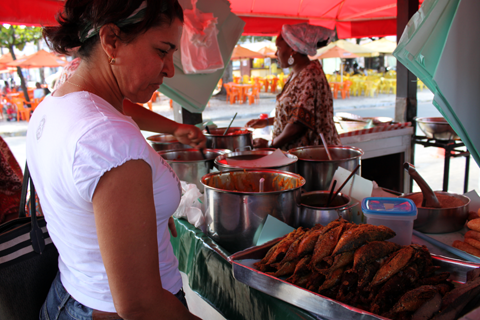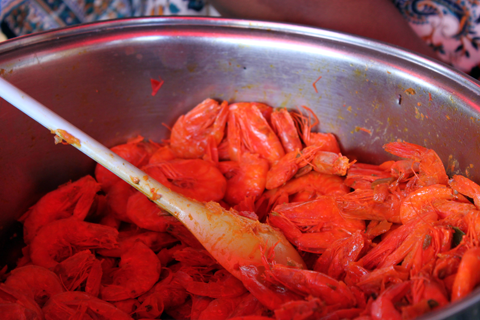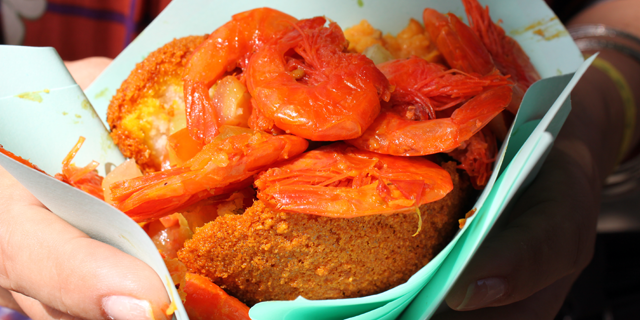In 2010, I visited Brazil for the first time. Like any hungry and curious wanderer, I pored over travel guides to begin to piece together a scavenger hunt of “must-sees” and, more importantly, “must-eats” for my trip. From Fodor’s to Rough Guides, Lonely Planet to TimeOut, everything I read told me I must taste acarajé. Apparently, these stuffed baseball-sized bean fritters fried in brick red dendê oil (a fragrant palm oil ubiquitous in Bahian cooking) are revered as the stuff of gastronomic legend.
Today, acarajé is considered Brazilian by birth. It’s tied, more specifically, to the city of Salvador—the capital of the state of Bahia, and the vibrant nucleus of Afro-Brazilian culture. But it doesn’t take much imagination to connect this humble food back to West Africa, from which it most certainly stems. Black-eyed peas? Definitely African. Palm oil? Came to the Americans with the colonists. And acarajé’s various stuffings? Vatapá—a blend of coconut milk, shrimp, ground peanuts and dendê —and caruru—a salad of whole shrimp, tomatoes and peppers—can both be traced right on back to ground zero of the diaspora.

Acarajé didn’t sound like much. Indeed, on my first trip to Brazil—from Rio to the streets of Salvador—each time I tried a serving, I found it flat-flavored, heavy and disappointing. I thought that I had been duped. I kept right on thinking that until my most recent visit to Salvador when, luckily for me, Bahia-born chef Tereza Paim took it upon herself to lead me to the real deal.
The late morning sun was hot as we drove along the city’s coastline. We left the more affluent neighborhoods, and entered a seemingly endless stretch of slums with million dollar views of the crashing sea. In front of a sort of beachfront strip-mall in the Itapuã neighborhood, Tereza screeched her car to a halt and hopped out. “We’re going to eat the best acarajé in Salvador,” she crowed as she led me along the crowded sidewalk.
We arrived before a red street vendor’s tent on which was printed the words “Acarajé de Cira”. Voluptuous Baianas—women of the region who don billowing dresses, wrap their heads in scarves and tend to churn out incredible food—stood over enormous vats of boiling dendê. The members of the growing crowd were either chewing contentedly at their tables in the sunshine or waiting patiently on line to place their orders.
We followed suit. Tereza ordered me an acarajé stuffed with caruru. I watched the cooks deftly stuff and fry, turn and wrap, while we waited. Then I ran across the street to order a coco bem gelado—a very cold green coconut with a straw stuck down into its core.
Back at the bustling food hub, I found Tereza already waiting for me. She handed me my lunch, a beautifully golden and crisp orb slashed down the middle, with pink whole shrimp spilling out from the steaming center. It was wrapped, simply, in a square of butcher paper. I dove in.

It's difficult to describe a perfect food. It’s even more difficult to define what makes a perfect food moment so…well, perfect. But this fit the bill. This acarajé wasn’t heavy at all, but rather soufflé-like. The brininess of the shrimps, their thin shells crunching under the soft pillow of oniony bean puree, the cool of the chopped tomatoes and the heat of the hot sauce drizzled over top all came together to make magic. “So this is what everyone’s been raving about,” I mused to myself as I wolfed down my portion, too infatuated to eat patiently. Tereza watched me, amused. She explained that the secret is quick, hot frying and very fresh dendê—the oil, apparently, goes rancid quite quickly, a curse in a region as hot and humid as Bahia. Still, though, even with good ingredients, a cook needs the perfect touch. And that’s what’s lacking in most acarajés.
I can’t vouch for any other acarajé in Brazil. In fact, I’d recommend against ordering the dish unless you can go straight to the best. Get yourself a ticket to Salvador, and make your way—whether by bus, bicycle or foot—to Acarajé de Cira. Make sure to eat your acarajé out of doors, with the heady scent of hot dendê and frying onions mingling with the salt off the ocean. With a big green coconut and a cold bottle of beer, I can’t imagine anything more satisfying. And unless someone can convince my tastebuds otherwise, I’m dubbing Cira’s the best acarajé in Brazil.
Acarajé de Cira
Rua Aristides Milton 285-1865
Itapuã (near Posto 12 on the beach)
Salvador de Bahia
(10am – 11 pm, Monday – Sunday)


![Making Mealtime Matter with La Familia: Easy Sofrito [Video]](https://thelatinkitchen.com/wp-content/uploads/2015/10/sofrito-shutterstock__0-500x383.jpg)
![Easy Latin Smoothies: Goji Berry Smoothie [Video]](https://thelatinkitchen.com/wp-content/uploads/2015/12/goji_berry-shutterstock_-500x383.jpg)
















![Fun and Fast Recipes: Fiesta Cabbage Salad [Video]](https://thelatinkitchen.com/wp-content/uploads/2015/11/fiesta_cabbage_slaw-shutterstock_-500x383.jpg)









